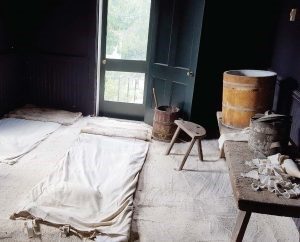
The interior of the Pest House in Lynchburg, Virginia. Note the barrel of linseed oil and limewater near the door to treat smallpox sores. The floor is covered with white sand, swept away daily, and sheets for patients to rest on. The black walls helped ease the eye stress and pain caused by the disease. (Photo by The Municipal.Com)
With all the foul weather our nation has suffered recently and the near influenza epidemic here in Texas it’s time to look at a 19th century method to control infectious diseases and prevent a pandemic. At such times when medical science was limited and entire families died, one solution was the Pest House.
The name Pest House was derived from the Middle Ages term pestilence, used to describe the plague. Nothing sends colder chills down the spine than the mere mention of the plague.
But plague was not the main epidemic for the Pest House. Typhoid, yellow fever, smallpox, scarlet fever, typhus, cholera, tuberculosis and influenza sent poor and homeless persons to the Pest House. Large cities, small towns, and villages all coped with epidemics in this manner.
Any semi-inhabitable structure served as the Pest House. Most were located near railroads and maybe brothels, surrounded by a graveyard. Those who died were quickly buried in the nearby Potter’s Field.
Some survived as conditions varied. In a few communities a doctor and nurse cared for the patients while in other places anyone who had survived the epidemic and was therefore immune volunteered to care for them. Surviving a contagious disease did not mean the caregiver was medically trained.
Other towns required the dying to bring their own food and bedding. Food might be delivered and left on the porch to prevent spreading the disease. Clinical care and cleanliness were non-existent.
Often the rooms inside the Pest House were painted black to protect the patient’s eyes from small pox damage. One doctor in Virginia during the Civil War spread white sand on the floor daily to overcome the vile odors. Then he laid cloth over the sand for patients’ beds. He also kept a barrel of linseed oil and limewater at the door to use as an ointment for sores. The mortality rate at his Pest House dropped from 50% to 5%.
Greenville had at least one Pest House located near the intersection of the Texas Midland Railroad and the Katy Railroad, close to the northwest corner of East Mount Cemetery. While no white sand and black walls welcomed the ill, it did house the local millionaire who contacted small pox during the early 1890s. It has always been a puzzle why Tom King recuperated from the dreadful disease at such a place when he and his family resided in the largest home in town. But he did, he survived, and went on to bigger and better things.
Sometime in the early 20th century, three members of the School Board took Hunt County to court to remove the Pest House. It was fairly near a public school and in all fairness should be removed. However, the District Judge declared that three individual members of the school board could not act alone for the board and declared in favor of the county.
This Pest House had been the brothel run by Clio Haskell. When fined and sentenced to time in jail, Haskell sold her structure to the commissioners’ court that converted it into the last Pest House in town. Shortly thereafter it was razed.

Did Hunt Co also have a “poor farm”. I taught school n Denton for 3 decades and heard mention of the county poor farm there.